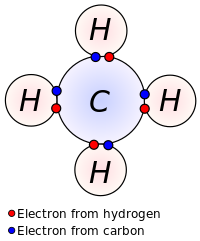"Covalent" redirects here. For other uses, see Covalent (disambiguation).
A covalent bond is a chemical bond that involves the sharing of electron pairs between atoms. The stable balance of attractive and repulsive forces between atoms when they share electrons is known as covalent bonding.For many molecules, the sharing of electrons allows each atom to attain the equivalent of a full outer shell, corresponding to a stable electronic configuration.
Covalent bonding includes many kinds of interactions, including σ-bonding, π-bonding, metal-to-metal bonding,agostic interactions, and three-center two-electron bonds. The term covalent bond dates from 1939.The prefix co- means jointly, associated in action, partnered to a lesser degree, etc.; thus a "co-valent bond", in essence, means that the atoms share "valence", such as is discussed in valence bond theory. In the molecule H
2, the hydrogen atoms share the two electrons via covalent bonding.Covalency is greatest between atoms of similar electronegativities. Thus, covalent bonding does not necessarily require that the two atoms be of the same elements, only that they be of comparable electronegativity. Covalent bonding that entails sharing of electrons over more than two atoms is said to be delocalized.
2, the hydrogen atoms share the two electrons via covalent bonding.Covalency is greatest between atoms of similar electronegativities. Thus, covalent bonding does not necessarily require that the two atoms be of the same elements, only that they be of comparable electronegativity. Covalent bonding that entails sharing of electrons over more than two atoms is said to be delocalized.
Contents
History
The term "covalence" in regard to bonding was first used in 1919 by Irving Langmuir in aJournal of the American Chemical Society article entitled "The Arrangement of Electrons in Atoms and Molecules". Langmuir wrote that "we shall denote by the term covalencethe number of pairs of electrons that a given atom shares with its neighbors."
The idea of covalent bonding can be traced several years before 1919 to Gilbert N. Lewis, who in 1916 described the sharing of electron pairs between atoms. He introduced the Lewis notation or electron dot notation or Lewis dot structure, in which valence electrons (those in the outer shell) are represented as dots around the atomic symbols. Pairs of electrons located between atoms represent covalent bonds. Multiple pairs represent multiple bonds, such as double bonds and triple bonds. An alternative form of representation, not shown here, has bond-forming electron pairs represented as solid lines.
Physical properties of covalent compounds (polar and non-polar)
| Physical properties | Covalent compounds |
|---|---|
| States (at room temperature) | Solid, liquid, gas |
| Electrical conductivity | Usually none |
| Boiling point and Melting point | Varies, but usually lower than ionic compounds |
| Solubility in water | Varies, but usually lower than ionic compounds |
| Thermal conductivity | Usually low |
Polarity of covalent bonds
Covalent bonds are affected by the electronegativity of the connected atoms. Two atoms with equal electronegativity will make nonpolar covalent bonds such as H–H. An unequal relationship creates a polar covalent bond such as with H−Cl.
Subdivision of covalent bonds
There are three types of covalent substances: individual molecules, molecular structures, and macromolecular structures. Individual molecules have strong bonds that hold the atoms together, but there are negligible forces of attraction between molecules. Such covalent substances are usually gases, for example, HCl, SO2, CO2, and CH4. In molecular structures, there are weak forces of attraction. Such covalent substances are low-boiling-temperature liquids (such as ethanol), and low-melting-temperature solids (such as iodine and solid CO2). Macromolecular structures have large numbers of atoms linked in chains or sheets (such as graphite), or in 3-dimensional structures (such as diamond and quartz). These substances have high melting and boiling points, are frequently brittle, and tend to have high electrical resistivity. Elements that have highelectronegativity, and the ability to form three or four electron pair bonds, often form such large macromolecular structures.

